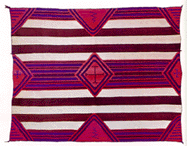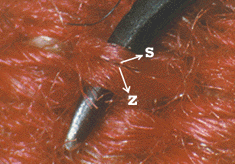Raveled Plied Yarns Natural Red Dyes Dye Standard Collections
Navajo blankets and Navajo rugs are artifacts of a living people's past. These beautiful Navajo textiles that include serapes, blankets, belts, mantas, and dress panels are the prolific and creative textile art of a group of indigenous people who have lived here in the southwestern United States for at least 700 to 800 years. Some of the Navajo themselves have declared themselves to be the Anasazi who disappeared at 1200 - 1300 A.D. This is controversial for many reasons. The Anasazi are known today as the ancestral Pueblo people and we believe they were primarily a sedentary farming and ceramic culture like the pueblos of today, but there are Anasazi textiles that have survived 700 to 1200 years as rare examples that are mostly fragments in museums.
The Navajo's linguistic characteristics allow us to trace the Navajo's language to Western Athapaskan that includes Chiricahua, Mescalero, and Western Apache, as well as tribes in the Northwestern coastal area known as Eyak and Haida, and up to Alaskan Eskimo Tlingit. This linguistic line to the Northwest coast may indicate migration routes that the Navajo took from the North 800 years ago.
Navajo history is kept as oral traditions
that the man who discovered Mesa Verde's array of cliff dwellings/pueblos
during the late 1800's spoke of from his conversations with the Navajo
who shared many festivals, meals, and heart to heart talks with him.
"Anasazi, said Richard (Wetherill), was a Navajo word. The
Navajo used it to describe the ancient people, now vanished, whose ruined
dwellings the Navajo found when they migrated into the Four Corners
region from the northward."
"In a loose, vague sense Anasazi
meant ancient enemies. Richard did not know if this implied that the
first of the Navajos had found some of these early ones still in their
pueblos and cliff dwellings, and made war upon them." (McNitt,
Frank. Anasazi. Albuquerque: University of
New Mexico Press, 1991.) Page 57.
Warfare, raiding, and nomadic hunter and gather life styles are another way the Navajo could have "become" to the ancestral Pueblo peoples, by having children with them. During the Pueblo Revolt of 1680 the Navajo joined the ancestral Pueblo-Anasazi people fighting for their freedom from the Spanish, and they succeeded in expelling the Spanish from the southwest for a few years. During the Re-conquest many Pueblo refugees took shelter with their allies in the lands of the Navajo.
Pottery types from Dinetah Utility (cooking vessels) to Jemez black on white, polychromes and late glazes and Tewa types were found in the Navajo Reservoir area on the upper San Juan in Utah, Arizona, and New Mexico. They had many cultural influences in the process of becoming who they are today and Pueblo mantas and weaving traditions were among the shared qualities the Pueblo peoples brought to their Navajo hosts during the decades of Spanish oppression.
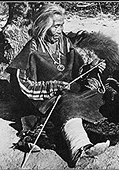 |
The Navajo adapted the
Pueblo techniques of weaving cotton blankets, mantas, and used their
own styles as well as traditional Pueblo styles to trade back to
the Pueblos. Blankets were stylistically adapted to Spanish
or Mexican Saltillo serape design elements. The Navajo started
using a new color available in the Southwest because of trade from
Mexican cities that imported a red flannel cloth called bayeta or
baize. They would strip out or ravel the yarn from the flannel
cloth and re-twist it into new red yarn. |
| These bolts of wool flannel cloths and yarns (technically all wool bolt cloth is flannel ) became the preferred source of red color. The nomadic Navajo wove prolifically and with a zeal that was reported in Spanish journals to Amsden's book in 1934, their blankets became famous for technical quality, strength, and beauty. The red insect dye (Dactylopius coccus - Cochineal) came from Spain's new colonies in Mexico and South America. The yarns were dyed with Cochineal in Europe and imported to Mexico during the 18th to the 19th centuries. India was an English colony and supplied (Kerria lacca - Lac dye) for use on yarns and Baize, Bayeta, or flannel. | 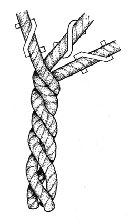 |
By the 19th century red yarns and flannel bolts were also being produced from the east coast of the United States using these natural red dyes. The U.S. mills shipped to trading posts using the Santa Fe trail that was a supplement to the Mexican trade at first, but eventually displaced trade from the south.
By the early 1800's to 1850 change in Mexican politics and years of revolution to eject Spain from Mexico and the growing influence of European pioneers from the U.S. or New Mexicans likely caused a shift in trade materials and red bolt cloths/flannel or high grade Saxony yarns to come primarily from the east coast of the United States or from trade with Europe and imported to the United States.
The Navajo did not take kindly to the New Mexicans or U.S. settlers either, but some advocated peace as early as 1818 with the Spanish and became the Enemy Navajo (dene 'ana'i) who even today remain separated from the main group of Navajo in the four corner area culturally and geographically. Victories against the Mexicans and losses varied through the decades of the first half of the 19th century took its toll and finally the U.S. Army entered into the fray in 1846. The end of organized hostility is marked by the forced march and containment of the Navajo at Bosque Redondo from 1864 to 1868. The ambiguous nature of war with European immigrants and settlers came to an end. The Navajo became less war oriented to survive and they as always adapted, as another step in the process of becoming the productive and creative people they have become today.
The Navajo focused on repopulating their tribe and expanding their trade within the newly formed United States. The used every kind of wool product they could find to weave every kind of weaving the trader at the trading post demanded or made popular. Germantown and Saxony yarns to Bayeta, and other raveled cloths, as well as a multitude of yarns from all over the world were imported into the U.S. Or manufactured here in the U.S. and brought down the Santa Fe trail for trade to the Navajo.
We have split the s-spun and z-spun raveled yarns
found in Navajo blankets and tested them separately finding distinct
dyes, dates, and evidence for cultural practices, trade routes, and
historical implications. Textile Dye
and Fiber Analysis Details
The mills in the eastern part of the United States were duplications of European mills with European mill workers and dye masters and this manufacturing capability combined with importing European yarns and cloths became the best source for Navajo weavers.
We have very little real historical accounts or just a few vague journal entries and shipping invoices for this entire period of 1800-1900. There were both natural insect dyes such as Lac or cochineal being used at the mills in the United states, Europe, and traded from Mexico or the U.S.. It is very difficult to determine where these yarns were originating and hearsay one hundred years later is an uncertain or a shaky basis for what we know about Navajo textiles today. The contemporary literature is derived from researching the scanty and general historical documents, and interviews from the early 1900's by such authors as Charles Avery Amsden and Gladys A Reichard who both published in the 1930's. Today much of the literature is based on this earlier well researched work. What you hear from salesmen and collectors is frequently based on these literary sources, as well as their own speculation and observations. Comparisons are also made with the few textiles in museums that have a provenience, but few if any of the textiles in the museums with a provenience talk of the yarns, fibers, or dyes, much less trade sources for the materials or the weaver's techniques.
The specific textile remains a mystery other than it is a Navajo weaving that is categorized by weaving style and yarn type. We can objectively identify churro fibers in yarns that came from the Spanish and Moreno yarns that primarily came from the U.S. and Europe. We also identify fibers like flax, silk, goat, and any others we might find to add more information and build a detailed analysis of a textile. This combined with dye analysis always contributes accurate insight into the specific textile and ties it to the literature.
With the railroad coming to New Mexico in 1880, American trade yarns and cloths displaced the trade from Mexico but the resourceful and frugal Navajo weavers likely saved yarns and cloths from previous decades and used cloths from their own clothing and older textiles. Traders and distributors to traders may have had bolts of lac dyed flannel and cochineal flannel side by side synthetic dyed flannel and distributed them to the Navajo. So what we see now in old Navajo textiles is an amalgamation of resource management that takes the form of several textures, color differences, and beauty. Now we can say this textile dates from possibly before 1860 if a natural dye is found in a yarn, to a few years after the patent date of the synthetic dye we find in a yarn. The date of the synthetic dye patent allows us to establish the oldest possible date for the textile's manufacture. The other and frequently older materials or the yarns dyed with natural dyes contribute historical and ethnological information previously ignored or not considered with newer synthetic dyed materials. Knowing the yarn was saved from decades before certainly brings the rich ethnological and historical qualities to the focus, not just the monetary value. It may have been her grandmother's yarn or from her older brother's or father's clothing. The possibilities become researchable and open doors of cultural and historical insight as the data base builds.
There are different techniques and materials incorporated into these artifacts from this volatile and quickly changing era. Frequently yarns from pre-1880 are blended with post 1880 yarns and we occasionally find yarns dyed with exotic wood grown only in Indonesia and traded by the Dutch to the European mills and then from the U.S. or Mexico importation, to the Navajo. Silken commercial yarns known as Zephyr or the highly processed Saxony yarns are also identifiable from the dyes and damaged cuticle area of the fibers as evidence of the worsted qualities from the milling. There are also varieties of yarns from any given point in time during the mid to late 1800's due to trade route convergence, new methods of yarn production or techniques, and new and old traditional dyes being used periodically in bolt cloth or flannel and yarn manufacturing.
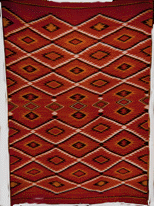 |
Objective specific dye and fiber analysis when combined with general information such as historical trends, trade routes, and manufacturing qualities becomes a well based factual outline of known information that can and often displaces the speculation or what we just did not know before the analysis. |
The value is enhanced because the collector or museum now has much more accurate information and specific reproducible facts about the textile that can be a useful reliable research data base. I have worked on textiles in museums here in New Mexico and found information that confirmed some of the published work and did not support others. The analysis always added to and frequently changed what was known and the general technical and historical information became more appropriate, specifically applied, and useful. The curators and research directors in the museums are not egoists and as researchers and scholars they search for knowledge even if the results are not expected or contradict previous understanding. They then adapt the results to their existing knowledge base. The kind of objective research we do here is helpful at any level of investigation and informative for the collector who just loves the art or even the seasoned expert, curator, or scholar. Please see Science and Textiles.
The question becomes not what do you know about your textile, but what do you base what you know on, and where did you get your information? These are valuable and more importantly historically and ethnologically rich objects of art. Even if one should just value them as monetary objects then an analysis may find natural dyes where only synthetics were known of before or we may find synthetic dyes where only natural dyes were previously identified before. The results of an analysis will fall on a continuum that will confirm what you know at one end, or change everything you know about the textile at the other end. One sure thing is that an objective knowledge base will be established. You will have a scientifically generated provenience that generates potential for more ethnological understanding and respect, and build a secure basis for establishing its monetary value after the analysis is done.
